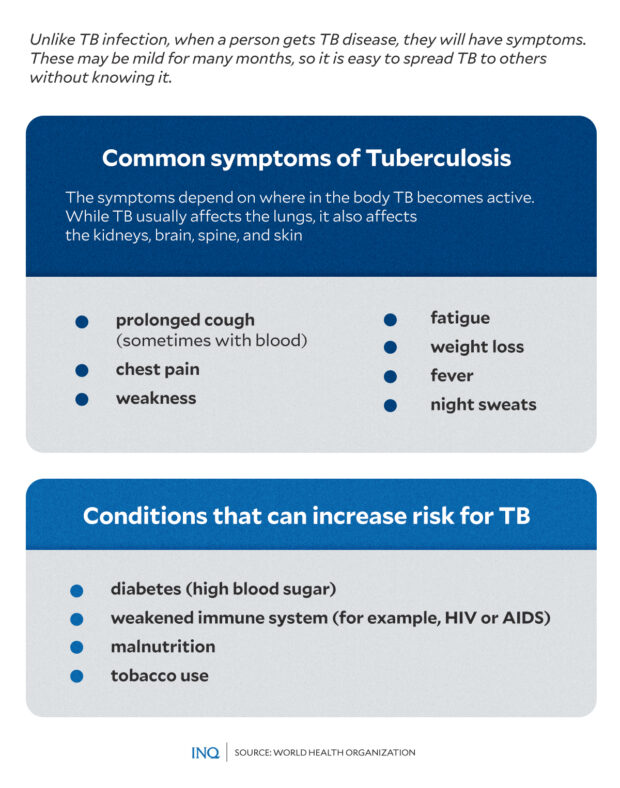MANILA, Philippines — Despite significant medical advances making tuberculosis (TB) preventable and usually curable, over 10 million people globally continue to contract the disease annually, including those in the Philippines, where it remains a leading cause of death.
TB is an infectious disease caused by the bacterium Mycobacterium tuberculosis. It primarily spreads through the air when individuals with an active infection cough, releasing the bacteria. According to the World Health Organization (WHO), it is estimated that around a quarter of the global population has been infected with the disease, highlighting its widespread nature.
Recent advancements in the field have significantly enhanced the diagnostics, treatment, and prevention of TB. Currently, several rapid molecular tests are recommended by WHO as the first line of defense in identifying the disease, with some tests capable of detecting cases resistant to drugs.
For those with TB susceptible to drugs, a robust six-month antibiotic regimen has proven to be highly effective, boasting success rates of at least 85%. On the preventive front, vaccinations play a crucial role in safeguarding children against TB infection and its more severe manifestations.
Despite these advancements, WHO’s 2023 Global Tuberculosis Report reveals a concerning trend: the global incidence of TB diagnoses is on the rise. Moreover, the report underscores that TB remained the second deadliest infectious disease worldwide in 2022, trailing only behind COVID-19, emphasizing the ongoing challenge that the disease presents to global health.
Global TB burden
In 2022, the global TB crisis deepened, with an estimated 10.6 million people infected, including 5.8 million men (55 percent), 3.5 million women (33 percent), and 1.3 million children (12 percent) aged 0 to 14 years.
That same year, WHO reported a record-high 7.5 million newly diagnosed TB cases since the inception of its global monitoring efforts in 1995.
This surge in cases not only exceeded the pre-COVID benchmarks but also surpassed the previous high of 7.1 million in 2019 and reflected a notable rise from the 5.8 million cases in 2020 and 6.4 million in 2021.
According to WHO, the increase in 2022 likely includes a considerable number of cases that went undiagnosed or untreated in previous years due to COVID-19 disruptions, which severely impacted health-care access and service provision.
Moreover, the year saw an alarming figure of approximately 41,000 people worldwide developing multidrug-resistant or rifampicin-resistant TB (MDR/RR-TB), a more severe form of the disease resistant to isoniazid and rifampicin, the two most potent first-line TB drugs.
However, the number of individuals diagnosed and started treatment for this condition lagged significantly, with only 175,650 people receiving treatment in 2022. This figure represents just two-fifths of those in need and is still below the pre-pandemic figure of 181,533 in 2019.
TB also accounted for approximately 1.3 million deaths globally in 2022, a slight reduction from the 1.4 million deaths in the preceding two years, yet a stark reminder of the disease’s lethality.
WHO noted that the pandemic has indirectly contributed to nearly half a million excess TB deaths over the past three years, deviating from the trajectory expected if pre-COVID trends had persisted.
Battle persists
In 2022, WHO reported a significant global rebound in the diagnosis and treatment of tuberculosis (TB), marking a promising shift from the setbacks caused by COVID-19 disruptions over the previous two years.
WHO noted that this recovery has begun to mitigate the adverse effects of the pandemic on TB mortality and morbidity rates.
The Philippines played a pivotal role in this turnaround, standing among the nations that contributed to over 60% of the global decrease in new TB diagnoses during the challenging years of 2020 and 2021. By 2022, the country, along with India and Indonesia, achieved diagnosis rates that surpassed those of 2019, demonstrating a noteworthy recovery.
However, the battle against TB is far from over. Data showed that 30 countries with the highest burdens of the disease were responsible for 87 percent of the global caseload in 2022.
The Philippines, accounting for 7.0 percent of the world’s TB cases, is part of a group of eight countries — including India (27 percent), Indonesia (10 percent), China (7.1 percent), Pakistan (5.7 percent), Nigeria (4.5 percent), Bangladesh (3.6 percent), and the Democratic Republic of the Congo (3.0 percent) — that together represent two-thirds of the global total.
This highlights the critical need for continued efforts in TB control and eradication, especially in high-burden countries like the Philippines.
TB in the Philippines
WHO’s latest data has highlighted the significant challenge tuberculosis (TB) continues to pose in the Philippines, revealing that in 2022, an alarming 737,000 individuals contracted TB. This translates to a new case every 43 seconds, underscoring the urgency of the situation.
The incidence rate of TB in the Philippines increased to 638 cases per 100,000 people, up by 6.9 percent from the 596 per 100,000 reported in 2021.
Of those who fell ill with TB in 2022, 435,890 were newly diagnosed and reported cases, marking a significant 36 percent increase from the 321,564 cases reported in the previous year.
The situation with drug-resistant TB, which is harder to treat, has also worsened. In 2022, 9,844 people were diagnosed with this form of TB, a 30 percent increase from the 7,589 cases recorded in 2021, bringing the total incidence of MDD/RR-TB in the country to 31,000 cases.
According to WHO, the prevalence of TB in the country can largely be linked to five key risk factors: undernutrition, smoking, alcohol use disorders, diabetes, and HIV (human immunodeficiency virus).
Previous studies have noted that these conditions not only predispose individuals to develop the disease but also complicate its treatment and management, highlighting the importance of addressing these underlying health issues as part of comprehensive TB control efforts.
More people treated, fewer deaths
Despite the concerning statistics highlighting TB’s prevalence in the Philippines, data showed a silver lining: treatment rates for both standard and drug-resistant TB have seen a significant uptick.
In 2022, a remarkable leap forward was made in the Philippines, with 44,417 individuals beginning TB preventive treatment.
This approach, endorsed by the World Health Organization (WHO), involves taking one or more anti-TB medications to stop the infection from progressing to an active disease. It is specifically designed for those who are infected with TB bacteria or have been exposed to it and are at an increased risk of developing the disease. This includes people living with HIV or those with weakened immune systems.
READ: DOH to expand free tuberculosis treatment services
This proactive step represented a 130 percent increase from the 19,096 people who embarked on preventive treatment in 2021, signaling a significant stride in TB prevention efforts.
Despite the challenges posed by drug-resistant TB — noted by WHO and the Department of Health (DOH) as more complex and costly to treat due to longer treatment durations — the country managed to enhance its treatment response. In 2022, 9,969 people started treatment for drug-resistant TB, up from 5,946 in the previous year.
READ: Consistent treatment crucial to ending TB
In 2022, the number of TB-related deaths in the Philippines decreased by 1.6 percent, with 40,100 deaths recorded, translating to a rate of 35 deaths per 100,000 people.
Still, data from the Philippine Statistics Authority (PSA) showed that respiratory tuberculosis remained among the top causes of mortality in the country — ranking eighth below chronic lower respiratory diseases, hypertensive diseases, and pneumonia.
President Ferdinand “Bongbong” Marcos Jr. has previously ordered the health department to focus on addressing HIV and TB infections.
READ: Marcos to DOH: Refocus drive on general public health, make HIV, TB fight a priority
READ: PSAC: 5 local manufacturers to produce anti-tuberculosis meds
Last week, the Private Sector Advisory Council (PSAC) Health Sector Group announced that five local drug manufacturers have signed up to participate in the production of anti-TB medicines.



